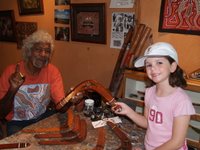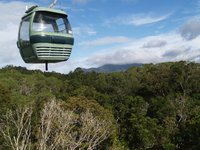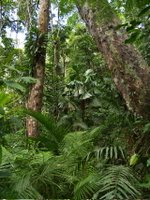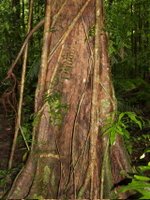Autumn Holiday - Week One
 orchestra pit and to watch all the singing and dancing from just the second row.
orchestra pit and to watch all the singing and dancing from just the second row.The thrills continued the next day as we departed for Brisbane to catch our morning flight and had to pull over not an hour out of Toowoomba so Hannah could relieve herself of her morning porridge. Yes, carsick again, and this time just on a straight highway! Luckily, the flight to Cairns was uneventful, and although there were a few clouds, we caught glimpses of the Great Barrier reef on the flight up. It is truly a wondrous sight to behold, and best seen from the air. The colours are almost irridescent and range from something bordering on electric blue to fluorescent green. Once arriving in Cairns, we picked up our rental car and headed north for the twenty minute drive to Palm Cove. In Palm Cove we had an apartment for the week and used that as the home base from which we took several day trips. The weather was not always cooperative, as the area received more wind and rain than usual for this time of year.

Palm Cove is a small town nestled along the shore of, you guessed it, a palm-lined cove. There are cobblestone streets and lush, immaculate gardens everywhere. Buildings are painted in bright colours such as yellow, pink, aquamarine, and lilac. One can walk the beach forever, minding the potential hazards, of course.
And what would this travel blog be if we didn't have yet another tale of danger? As the sign warns, sharks, crocodiles and marine stingers (jellyfish) inhabit the waters in this area. There are shark nets offshore and vinegar stations at every beach in case of jellyfish stings, but nothing to combat crocs, at least not that we could see, other than some good commom sense. The clincher with the jellyfish, however, is that you're lucky to get to the vinegar on time. The most deadly, the Box Jellyfish, can kill an adult male in a matter of seconds.
 Friends recounted a story of a man who went in headfirst to go snorkelling and dove right into a jellyfish. These seemingly harmless ones are small enough to fit on a man's head, and that's just what this one did. Witnesses say he had time to pull it from his face, scream, and then was dead! Stinger nets are put up in peak stinger season (about November/December to March/April) but they are not completely foolproof. Some inordinately large waves are enough to bring those nasty creatures into protected areas. There were Blue Bottles around when we were out, plus the water was really sandy, so we decided against swimming. Instead, we enjoyed some walks along the palm-fringed beach, a few quick
Friends recounted a story of a man who went in headfirst to go snorkelling and dove right into a jellyfish. These seemingly harmless ones are small enough to fit on a man's head, and that's just what this one did. Witnesses say he had time to pull it from his face, scream, and then was dead! Stinger nets are put up in peak stinger season (about November/December to March/April) but they are not completely foolproof. Some inordinately large waves are enough to bring those nasty creatures into protected areas. There were Blue Bottles around when we were out, plus the water was really sandy, so we decided against swimming. Instead, we enjoyed some walks along the palm-fringed beach, a few quick  dips in a cold pool, and leisurely strolls through colourful alleyways.
dips in a cold pool, and leisurely strolls through colourful alleyways.One night, we met up with Russell, Merilee, Rachel and James Howard, a family we'd met back home when we were both teaching at Meadowridge. They, too, were enjoying a vacation at Palm Cove and it was wonderful to visit some nine years after we'd last spent time together.

 One of our day trips from Palm Cove took us to Kuranda, a small arts and crafts village atop a mountain near Cairns. We travelled by steam train on the scenic and windy way up through Barron Gorge, relaxing in refurbished wooden cars, snapping pictures of waterfalls and canyons along the way. It was a bit like stepping back in time in Kuranda, something like being in colonial India. Lush vegetation, combined with the nostlagia
One of our day trips from Palm Cove took us to Kuranda, a small arts and crafts village atop a mountain near Cairns. We travelled by steam train on the scenic and windy way up through Barron Gorge, relaxing in refurbished wooden cars, snapping pictures of waterfalls and canyons along the way. It was a bit like stepping back in time in Kuranda, something like being in colonial India. Lush vegetation, combined with the nostlagia  of steam trains, made one forget that civilization was nearby. Our first stop in Kuranda was at the Butterfly Sanctuary, where we spotted the elusive Ulysses (Blue )Butterfly, a quick and erratic flier that is next to impossible to photograph. At one point, Hannah was sitting by the exit and had at least 10 butterflies on her. They were just gorgeous!
of steam trains, made one forget that civilization was nearby. Our first stop in Kuranda was at the Butterfly Sanctuary, where we spotted the elusive Ulysses (Blue )Butterfly, a quick and erratic flier that is next to impossible to photograph. At one point, Hannah was sitting by the exit and had at least 10 butterflies on her. They were just gorgeous!
From the butterfly sanctuary we headed to the markets where all manner of food and goods are for sale. After purchasing a few small souvenirs, we headed for something authentic. One of the local aboriginal craftsmen makes and paints boomerangs. It is  here we purchased an authentic boomerang, one with the dot paintings and carved to return when you throw it. After signing
here we purchased an authentic boomerang, one with the dot paintings and carved to return when you throw it. After signing  his work and providing Hannah with a brief lesson on how to hold and throw it, we were on our way to catch the gondola for the ride back down the mountain. What a unique trip it was, as this time we travelled above the rainforest canopy and were treated to an entirely different perspective from that of the trip up.
his work and providing Hannah with a brief lesson on how to hold and throw it, we were on our way to catch the gondola for the ride back down the mountain. What a unique trip it was, as this time we travelled above the rainforest canopy and were treated to an entirely different perspective from that of the trip up.
Yet another day trip took us from Port Douglas to the Outer Great  Barrier Reef. Together with some three hundred other tourists, we took a 90 minute ride out on a massive catamaran to a permanently moored platform from which you can snorkel, dive, go to an underwater viewing station, or take a glass-bottomed boat. It is a good thing we had Hannah take those extra swim lessons because, once covered from head to toe in her lycra suit, she practically dove off that platform right into the water. At first, it was difficult, too many people and choppy water, but once many of the snorkellers returned to eat or had had enough for the day,
Barrier Reef. Together with some three hundred other tourists, we took a 90 minute ride out on a massive catamaran to a permanently moored platform from which you can snorkel, dive, go to an underwater viewing station, or take a glass-bottomed boat. It is a good thing we had Hannah take those extra swim lessons because, once covered from head to toe in her lycra suit, she practically dove off that platform right into the water. At first, it was difficult, too many people and choppy water, but once many of the snorkellers returned to eat or had had enough for the day,  we went out to the end of the markers and circled a lagoon-like area where we saw giant clams, several variety of coral and some tropical fish. We were very disappointed, however, as it looked nothing like the vibrant colours displayed in the brochure. You cannot take thousands of people to a single site on the reef everyday and not expect it to have some impact. Together with coral bleaching (due to a rise in ocean temperatures), human presence has resulted in significant patches of the reef in this area being killed.
we went out to the end of the markers and circled a lagoon-like area where we saw giant clams, several variety of coral and some tropical fish. We were very disappointed, however, as it looked nothing like the vibrant colours displayed in the brochure. You cannot take thousands of people to a single site on the reef everyday and not expect it to have some impact. Together with coral bleaching (due to a rise in ocean temperatures), human presence has resulted in significant patches of the reef in this area being killed. From reef we then visited rainforest. North of Palm Cove is an area known as the Daintree, and it has some of the oldest rainforest in the world. It is the most diverse and complex region on the continent and many of the plant species have survived with little change. Even today, some of their descendants retain many of their primitive characteristics - some dating back over 110 million years! Of the 19 primitive flowering plant families on Earth, 12 are represented in the Daintree region. Listed as a World Heritage Site, Daintree National Park is home to some beautiful hiking trails, breathtaking beaches, and croc-infested rivers. For our first stop, we took
From reef we then visited rainforest. North of Palm Cove is an area known as the Daintree, and it has some of the oldest rainforest in the world. It is the most diverse and complex region on the continent and many of the plant species have survived with little change. Even today, some of their descendants retain many of their primitive characteristics - some dating back over 110 million years! Of the 19 primitive flowering plant families on Earth, 12 are represented in the Daintree region. Listed as a World Heritage Site, Daintree National Park is home to some beautiful hiking trails, breathtaking beaches, and croc-infested rivers. For our first stop, we took 
 a walk through Mossman Gorge. The mosses, ferns and fast-flowing rivers reminded us very much of Cliff or Alouette Parks. We saw some beautiful fig trees, rainforest fruits, and an abundance of vines. In fact, many of the trees were covered in an assortment of vines, as many as five or six different types. It became quite conceivable, after being in this tropical jungle, that Tarzan could indeed have been swinging on vines from one tree to the next. As you can see in the one photo, some of the vines are so thick, and have grown in such a fashion that they are wound
a walk through Mossman Gorge. The mosses, ferns and fast-flowing rivers reminded us very much of Cliff or Alouette Parks. We saw some beautiful fig trees, rainforest fruits, and an abundance of vines. In fact, many of the trees were covered in an assortment of vines, as many as five or six different types. It became quite conceivable, after being in this tropical jungle, that Tarzan could indeed have been swinging on vines from one tree to the next. As you can see in the one photo, some of the vines are so thick, and have grown in such a fashion that they are wound 
 around one another, that they look like the ropes used to tie boats to docks. Many larger trees in these forests form thick roots at their bases, called buttress roots because they're like the flying buttresses of Rennaisance churches, through which they can gather more moisture.
around one another, that they look like the ropes used to tie boats to docks. Many larger trees in these forests form thick roots at their bases, called buttress roots because they're like the flying buttresses of Rennaisance churches, through which they can gather more moisture.
Although we didn't see any, these forests are home to many deadly snakes, some unusual birds such as the prehistoric-looking cassowary (pictured here), possums, lizards, colourful birds, and frogs. After crossing the  Daintree River on a cable ferry, we headed up a windy road to catch a fine view of the surrounding area and to go the Discovery Centre. Nestled right in the rainforest, you can walk beneath king ferns and palms and above the rainforest canopy to learn about the vegetation, birds, butterflies, and fruits of the rainforest. Most of the fruits and seeds are actually toxic, but the aboriginal people developed all sorts of ways to prepare them, including smashing, cooking, drying and soaking, that would remove the toxins.
Daintree River on a cable ferry, we headed up a windy road to catch a fine view of the surrounding area and to go the Discovery Centre. Nestled right in the rainforest, you can walk beneath king ferns and palms and above the rainforest canopy to learn about the vegetation, birds, butterflies, and fruits of the rainforest. Most of the fruits and seeds are actually toxic, but the aboriginal people developed all sorts of ways to prepare them, including smashing, cooking, drying and soaking, that would remove the toxins.
Departing the Discovery Centre, we continued on our journey north until we could go no farther on paved roads and found ourselves at Cape Tribulation. Along the way, we stopped at Coconut Beach, which was very obviously and appropriately named, we later found out, as there are hundreds of coconuts strewn along the palm-lined beach. It is here we did a bit of beachcombing, and Hannah found a beautiful shell. Much to her surprise, and disgust, it was still inhabited, so she returned it to its sea habitat rather than add it  to her ever-expanding collection. These beaches are absolutely full of shells and dead coral.
to her ever-expanding collection. These beaches are absolutely full of shells and dead coral.
Yet another day trip took us inland to a different kind of national park, this time a volcanic one! After a rather harrowing 4-hour drive inland in some rainy and foggy weather and on some single-lane roads frequented by road trains (semi-trailer trucks pulling three trailers) that do not  pull over when you approach, we
pull over when you approach, we  reached our destination, Undara National Volcanic Park. In contrast to the lush, dense rainforest of the previous day, Undara is surrounded by dry rainforest which, admittedly, sounds rather strange. It is much like savannah, with grasses blanketing that rich red earth. Once in the park, we set off with a fun-loving group on a guided three hour tour through some of the most spectacular and well-preserved lava tubes on Earth. These tubes snake underground through thousands of kilometers in this area like veins through the human body.
reached our destination, Undara National Volcanic Park. In contrast to the lush, dense rainforest of the previous day, Undara is surrounded by dry rainforest which, admittedly, sounds rather strange. It is much like savannah, with grasses blanketing that rich red earth. Once in the park, we set off with a fun-loving group on a guided three hour tour through some of the most spectacular and well-preserved lava tubes on Earth. These tubes snake underground through thousands of kilometers in this area like veins through the human body.
 Formed one hundred and ninety thousand years ago when rivers of molten rock flowed through the valleys, the outside edges of these rivers of lava hardened, turning to rock. Eventually, the lava inside ran dry, leaving a hollow tube underground. Some of these tubes, with only the top half or third exposed, were easily two storeys high. With beautiful markings and colours, not to mention a few bats and bones from what appear to be kangaroos, these tubes are nothing short of awe-inspiring. It is truly fascinating what nature can do. One of the lava flows from Undara extends more then 160 kms, making it one of the longest lava flows from a single volcano on planet Earth in modern geological times.
Formed one hundred and ninety thousand years ago when rivers of molten rock flowed through the valleys, the outside edges of these rivers of lava hardened, turning to rock. Eventually, the lava inside ran dry, leaving a hollow tube underground. Some of these tubes, with only the top half or third exposed, were easily two storeys high. With beautiful markings and colours, not to mention a few bats and bones from what appear to be kangaroos, these tubes are nothing short of awe-inspiring. It is truly fascinating what nature can do. One of the lava flows from Undara extends more then 160 kms, making it one of the longest lava flows from a single volcano on planet Earth in modern geological times.

Our final day trip took us just a half-hour drive north to Hartley's Adventure Park. It is here we saw firsthand what killing machines crocodiles really are. There was Paul, a croc only half-grown, who already measured 4.5 meters, and Sully, named after the family dog that jumped into a watering hole outside of Innisfail before the three younger children did! Most of the crocs in this park have been captured because they are
 nuisances or have wandered too close to areas humans inhabit. Before leaving on a boat ride through the park, our guide instructed us to not put our hands, heads, or photographic equipment out the sides or back of the boat. We were seated at the very back of the boat and I soon understood the severity of his warnings, as I looked over my shoulder when we pulled away from the dock and there was "Bob", a rather innocent-looking croc following us, his snout just inches out of the water. Bob stalked us, which is something crocs are famous for, until the boat stopped and we got to see the top quarter of him leap out of the water for a chicken held out on the end of a stick. Innocent he is NOT! The snap of the jaws echoed throughout the valley. It is enough to make shivers go down your back. What an awful way to die.
nuisances or have wandered too close to areas humans inhabit. Before leaving on a boat ride through the park, our guide instructed us to not put our hands, heads, or photographic equipment out the sides or back of the boat. We were seated at the very back of the boat and I soon understood the severity of his warnings, as I looked over my shoulder when we pulled away from the dock and there was "Bob", a rather innocent-looking croc following us, his snout just inches out of the water. Bob stalked us, which is something crocs are famous for, until the boat stopped and we got to see the top quarter of him leap out of the water for a chicken held out on the end of a stick. Innocent he is NOT! The snap of the jaws echoed throughout the valley. It is enough to make shivers go down your back. What an awful way to die.At the park, they also had special shows going on for all the school children on holiday. One was an absolutely hilarious presentation on a less than humourous subject, snakes. The snake handler had a python you could "pet", too. Hannah opted to have her photo taken instead with a baby croc that had its snout taped shut, but she did get close enough to t
 he snake to give it a
he snake to give it a  touch. Brave girl! Other presentations included ones on bandicoots and the lace monitor, as well as a local species of turtle, with live specimens of all of the above being passed around so everyone could have a "cuddle". The big show came in the afternoon when one man and a croc were in the small auditorium. If it is at all possible, this guy is crazier than Steve Irwin. Unlike Steve's show, there are no extra people around to help in case the croc does something unexpected, and since the auditorium is so small, you're meters away from witnessing a potentially gruesome event. We spoke with the young fellow after the show and Dale asked if he could get insurance for the work he does. He laughed and replied that, yes, it was possible to get it as a croc handler but not when he worked at the park as a gardener/landscaper because I guess there had been too many claims for back and knee problems. How amusing!
touch. Brave girl! Other presentations included ones on bandicoots and the lace monitor, as well as a local species of turtle, with live specimens of all of the above being passed around so everyone could have a "cuddle". The big show came in the afternoon when one man and a croc were in the small auditorium. If it is at all possible, this guy is crazier than Steve Irwin. Unlike Steve's show, there are no extra people around to help in case the croc does something unexpected, and since the auditorium is so small, you're meters away from witnessing a potentially gruesome event. We spoke with the young fellow after the show and Dale asked if he could get insurance for the work he does. He laughed and replied that, yes, it was possible to get it as a croc handler but not when he worked at the park as a gardener/landscaper because I guess there had been too many claims for back and knee problems. How amusing!  That night, we headed into Cairns to the night markets for some small souvenir items before departing the next day for week two of holidays. We did well over 2500 km of driving on this first week of holidays, so we were looking forward to a week of genuine rest and relaxation on a tropical island south of Cairns.
That night, we headed into Cairns to the night markets for some small souvenir items before departing the next day for week two of holidays. We did well over 2500 km of driving on this first week of holidays, so we were looking forward to a week of genuine rest and relaxation on a tropical island south of Cairns.

0 Comments:
Post a Comment
<< Home